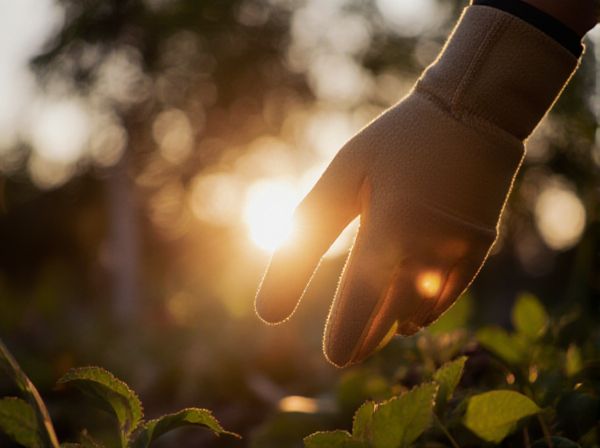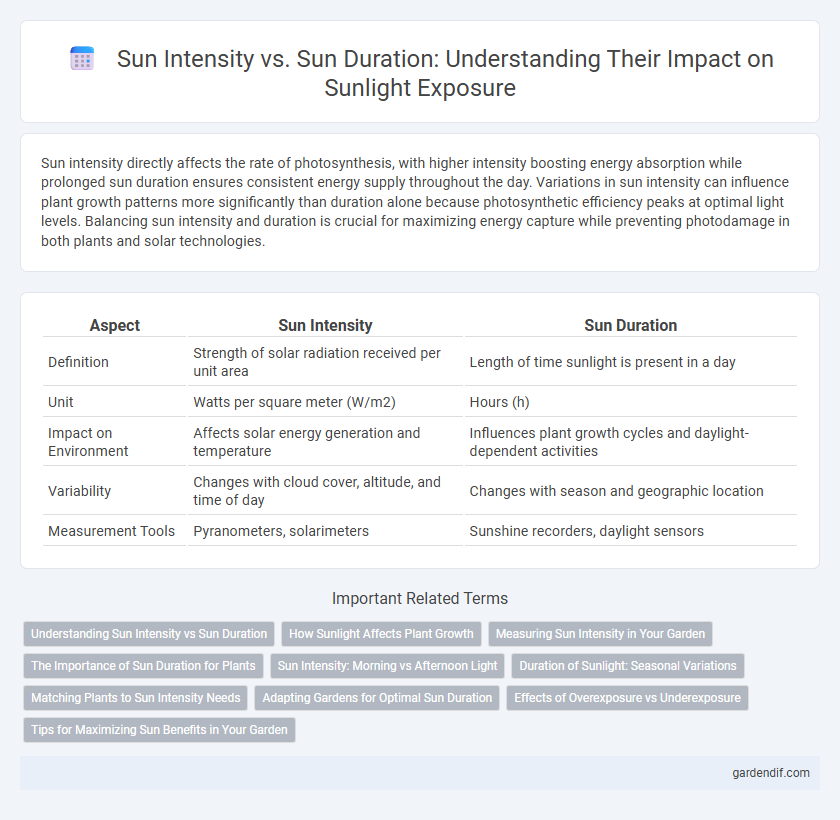
Sun Intensity vs Sun Duration Illustration
Sun intensity directly affects the rate of photosynthesis, with higher intensity boosting energy absorption while prolonged sun duration ensures consistent energy supply throughout the day. Variations in sun intensity can influence plant growth patterns more significantly than duration alone because photosynthetic efficiency peaks at optimal light levels. Balancing sun intensity and duration is crucial for maximizing energy capture while preventing photodamage in both plants and solar technologies.
Table of Comparison
| Aspect | Sun Intensity | Sun Duration |
|---|---|---|
| Definition | Strength of solar radiation received per unit area | Length of time sunlight is present in a day |
| Unit | Watts per square meter (W/m2) | Hours (h) |
| Impact on Environment | Affects solar energy generation and temperature | Influences plant growth cycles and daylight-dependent activities |
| Variability | Changes with cloud cover, altitude, and time of day | Changes with season and geographic location |
| Measurement Tools | Pyranometers, solarimeters | Sunshine recorders, daylight sensors |
Understanding Sun Intensity vs Sun Duration
Sun intensity measures the strength of solar radiation reaching the Earth's surface, while sun duration refers to the total hours of sunlight received in a day. Higher sun intensity means more concentrated energy per unit area, boosting photosynthesis and solar power generation, whereas longer sun duration accumulates more total solar energy over time. Understanding the balance between sun intensity and sun duration is crucial for agriculture, renewable energy planning, and climate modeling to optimize resource use and environmental impact.
How Sunlight Affects Plant Growth
Sunlight intensity directly influences photosynthesis rate by providing the energy plants need to produce food, while sun duration determines the total light exposure necessary for optimal growth and development. Higher sun intensity increases chlorophyll production and accelerates growth, yet excessive intensity can cause leaf damage and stress. Extended sun duration improves carbohydrate accumulation and flowering but must be balanced to prevent photoinhibition and maintain plant health.
Measuring Sun Intensity in Your Garden
Measuring sun intensity in your garden involves using a lux meter or a sunlight meter to record the amount of light your plants receive at different times of the day, ensuring optimal growth conditions. Sun intensity affects photosynthesis rates and plant health, making precise measurement crucial for garden planning and plant selection. Tracking sun duration alongside intensity helps identify the best locations for sun-loving versus shade-tolerant plants.
The Importance of Sun Duration for Plants
Sun duration plays a critical role in plant growth by influencing photosynthesis beyond just sun intensity. Extended periods of sunlight enable plants to maximize energy absorption, supporting vital processes like flowering and seed production. Consistent sun duration ensures the regulation of circadian rhythms, directly impacting plant health and productivity.
Sun Intensity: Morning vs Afternoon Light
Sun intensity varies significantly between morning and afternoon light, with afternoon sunlight typically exhibiting higher intensity due to the sun's position being closer to its zenith. Morning light offers lower intensity but richer in warm, diffused tones, contributing to softer shadows and reduced UV exposure. This variation impacts photosynthesis rates, solar panel efficiency, and human circadian rhythms, emphasizing the need to optimize energy capture and health benefits based on sun intensity rather than just duration.
Duration of Sunlight: Seasonal Variations
Sunlight duration fluctuates significantly throughout the year due to Earth's axial tilt, causing seasonal variations in daylight hours. Longer sunlight duration in summer months enhances photosynthesis and impacts climate patterns by increasing solar energy absorption. Conversely, shorter daylight in winter results in reduced solar intensity and lower ambient temperatures.
Matching Plants to Sun Intensity Needs
Matching plants to sun intensity needs requires understanding the relationship between sun intensity and sun duration, as some plants thrive under high-intensity sunlight for short periods while others require lower intensity over longer durations. Plants like succulents and cacti prefer intense, direct sunlight for several hours, whereas shade-loving plants such as ferns thrive with indirect or filtered sunlight throughout the day. Optimizing plant health involves measuring light intensity in lux or foot-candles and ensuring the duration aligns with each species' specific photosynthesis requirements.
Adapting Gardens for Optimal Sun Duration
Sun intensity varies throughout the day and impacts garden health, making it essential to adapt planting strategies based on sun duration to ensure optimal photosynthesis and growth. Selecting shade-tolerant plants for areas with prolonged intense sunlight and sun-loving varieties for shorter, moderate sun durations maximizes garden resilience. Monitoring sunlight patterns with tools like light meters helps gardeners adjust plant placement and irrigation schedules accordingly for better yield.
Effects of Overexposure vs Underexposure
Sun intensity combined with sun duration directly impacts skin health, where overexposure to high-intensity sunlight increases risks of sunburn, premature aging, and skin cancer due to excessive ultraviolet (UV) radiation. Underexposure to sunlight limits vitamin D synthesis, potentially causing deficiencies that affect bone health and immune function. Balancing moderate sun exposure optimizes benefits while minimizing harmful effects related to UV intensity and exposure duration.
Tips for Maximizing Sun Benefits in Your Garden
Maximizing sun benefits in your garden requires balancing sun intensity and duration to boost photosynthesis and plant growth. Position sun-loving plants in areas with at least 6 to 8 hours of direct sunlight, while using shade or partial sun zones for more delicate species. Regularly monitor sunlight patterns throughout the seasons to adjust plant placement and optimize exposure for healthier, more productive gardens.
Sun Intensity vs Sun Duration Infographic

 gardendif.com
gardendif.com